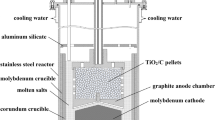Abstract
In this work, the dissolution of Ti ions from a sacrificial Ti anode during electrolysis on the reduction behavior of Ti–Al alloy electrodeposits from a Lewis acidic eutectic mixture of 1-ethyl-3-methylimidazolium chloride (EMIC) and a 0.667-mol fraction of aluminum chloride (AlCl3) is investigated. The Ti ions are dissolved in EMIC-AlCl3 ionic liquid (IL) by potentiostatic and galvanostatic electrolysis using chronoamperometry (CA) and chronopotentiometry (CP) techniques, respectively. At the same time, the electrodeposition of the Ti–Al alloy is accomplished on the copper cathode electrode at 383 K using the Ti anode. The dissolution, concentration, and deposition of Ti species are controlled by varying the electrolysis current, potential, and the electrolysis duration (1–3 h). The electrochemical reduction behavior of Ti and Al ions is studied on all Pt wire electrodes using cyclic voltammetry (CV). SEM studies revealed homogeneous and crystalline Ti–Al electrodeposits for CP-electrolysis. EDS and XRD revealed 16 at %. Ti with a cubic Ti0.12Al0.88 phase of Ti–Al alloy obtained from 1 h CP-electrolysis. The Ti content in Ti–Al alloy decreased with an increase in electrolysis time.
Access this chapter
Tax calculation will be finalised at checkout
Purchases are for personal use only
Similar content being viewed by others
References
Kroll W (1940) The production of ductile titanium. Trans Electrochem Soc 78:35
Crowley G (2003) How to extract low-cost titanium. Adv Mater Processes 161:25–27
Zhang M, Kamavaram V, Reddy RG (2006) Ionic liquid metallurgy: novel electrolytes for metals extraction and refining technology. Mining Metall Explor 23:177–186
Fung KW, Mamantov G (1972) Electrochemistry of titanium (II) in AlCl3-NaCl melts. J Electroanal Chem 35:27–34
Girginov A, Tzvetkoff TZ, Bojinov M (1995) Electrodeposition of refractory-metals (Ti, Zr, Nb, Ta) from molten-salt electrolytes. J Appl Electrochem 25:993–1003
Rolland W, Sterten A, Thonstad J (1987) Electrodeposition of titanium from chloride melts. ProcElectrochemSoc 7:775–785
Head RB (1961) Electrolytic production of sintered titanium from titanium tetrachloride at a contact cathode. J Electrochem Soc 108:806–809
Stafford GR (1994) The electrodeposition of Al3Ti from chloroaluminate electrolytes. J Electrochem Soc 141:945–953
Carlin RT, Osteryoung RA, Wilkes JS, Rovang J (1990) Studies of titanium (IV) chloride in a strongly Lewis acidic molten-salt-electrochemistry and titanium NMR and electronic spectroscopy. Inorg Chem 29:3003–3009
Stafford GR, Moffat TP (1995) Electrochemistry of titanium in molten 2AlCl3-NaCl. J Electrochem Soc 142:3288–3296
Koronaios P, King D, Osteryoung RA (1998) Acidity of neutral buffered 1-Ethyl-3-methylimidazolium chloride-AlCl3 ambient-temperature molten salts. Inorg Chem 37:2028–2032
Jiang T, ChollierBrym MJ, Dubé G, Lasia A, Brisard GM (2006) Electrodeposition of aluminium from ionic liquids: part I—Electrodeposition and surface morphology of aluminium from aluminium chloride (AlCl3)–1-ethyl-3-methylimidazolium chloride ([EMIm]Cl) ionic liquids. Surf Coat Technol 201:1–9
Kamavaram V, Mantha D, Reddy RG (2005) Recycling of aluminum metal matrix composite using ionic liquids: effect of process variables on current efficiency and deposit characteristics. Electrochim Acta 50:3286–3295
Liao Q, Pitner WR, Stewart G, Hussey CL, Stafford GR (1997) Electrodeposition of aluminum from the aluminum chloride-1-methyl-3-ethylimidazolium chloride room temperature molten salt + benzene. J Electrochem Soc 144:936–943
Zhao Y, VanderNoot T (1997) Electrodeposition of aluminium from room temperature AlCl3-TMPAC molten salts. Electrochim Acta 42:1639–1643
Karpinski ZJ, Osteryoung RA (1984) Determination of equilibrium-constants for the tetrachloroaluminate ion dissociation in ambient-temperature ionic liquids. Inorg Chem 23:1491–1494
Pradhan D, Reddy RG (2014) Mechanistic study of Al electrodeposition from EMIC-AlCl3 and BMIC-AlCl3 electrolytes at low temperature. Mater Chem Phys 143:564–569
Tang J, Azumi K (2011) Optimization of pulsed electrodeposition of aluminum from AlCl3-1-ethyl-3-methylimidazolium chloride ionic liquid. Electrochim Acta. 56:1130–1137
Wilkes JS, Levisky JA, Wilson RA, Hussey CL (1982) Dialkylimidazolium chloroaluminate melts—a new class of room-temperature ionic liquids for electrochemistry, spectroscopy, and synthesis. Inorg Chem 21:1263–1264
Pradhan D, Reddy RG (2009) Electrochemical production of Ti-Al alloys using TiCl4-AlCl3-1-Butyl-3-Methyl imidazolium chloride (BmimCl) electrolytes. Electrochim Acta 54:1874–1880
Song J, Wang Q, Wu J, Jiao S, Zhu H (2016) The influence of fluoride ions on the equilibrium between titanium ions and titanium metal in fused alkali chloride melts. Faraday Discuss 190:421–432
Song J, Xiao J, Zhu H (2017) Electrochemical behavior of titanium ions in various molten alkali chlorides. J Electrochem Soc 164:E321
Song Y, Jiao S, Hu L, Guo Z (2016) The cathodic behavior of Ti (III) Ion in a NaCl-2CsCl Melt. Metall Mater Trans B 47:804–810
Endres F, Zein El Abedin S, Saad AY, Moustafa EM, Borissenko N, Price WE, et al. (2008) On the electrodeposition of titanium in ionic liquids. PhysChemChemPhys 10:2189–2199
Bakkar A, Neubert V (2015) A new method for practical electrodeposition of aluminium from ionic liquids. Electrochem Commun 51:113–116
Zein El Abedin S, Giridhar P, Schwab P, Endres F (2010) Electrodeposition of nanocrystalline aluminium from a chloroaluminate ionic liquid. ElectrochemCommun 12:1084–1086
Böttcher R, Valitova A, Ispas A, Bund A (2019) Electrodeposition of aluminium from ionic liquids on high strength steel. Trans IMF 97:82–88
Okoturo OO, VanderNoot TJ (2004) Temperature dependence of viscosity for room temperature ionic liquids. J Electroanal Chem 568:167–181
Acknowledgements
The authors acknowledge the financial support from the National Science Foundation (NSF) award number 1762522 and ACIPCO for this research project. The authors also thank the Department of Metallurgical and Materials Engineering, The University of Alabama, for providing the experimental and analytical facilities.
Author information
Authors and Affiliations
Corresponding author
Editor information
Editors and Affiliations
Rights and permissions
Copyright information
© 2021 The Minerals, Metals & Materials Society
About this paper
Cite this paper
Shinde, P.S., Reddy, R.G. (2021). Effect of Dissolution of Titanium Ions on Ti Alloys Electrodeposition from EMIC-AlCl3 Ionic Liquid at Low Temperature. In: Lee, J., Wagstaff, S., Anderson, A., Tesfaye, F., Lambotte, G., Allanore, A. (eds) Materials Processing Fundamentals 2021. The Minerals, Metals & Materials Series. Springer, Cham. https://doi.org/10.1007/978-3-030-65253-1_12
Download citation
DOI: https://doi.org/10.1007/978-3-030-65253-1_12
Published:
Publisher Name: Springer, Cham
Print ISBN: 978-3-030-65252-4
Online ISBN: 978-3-030-65253-1
eBook Packages: Chemistry and Materials ScienceChemistry and Material Science (R0)




